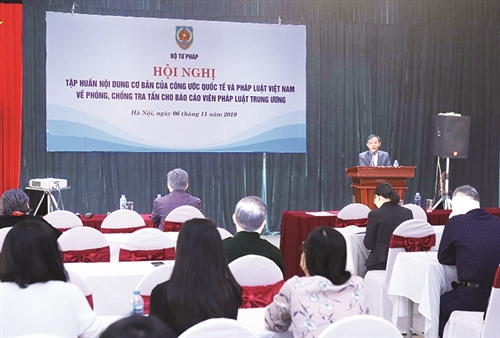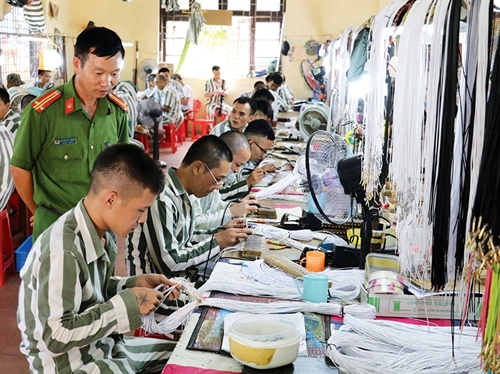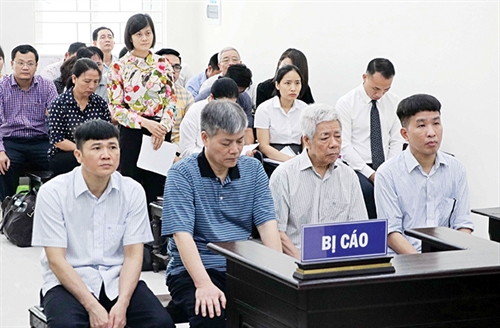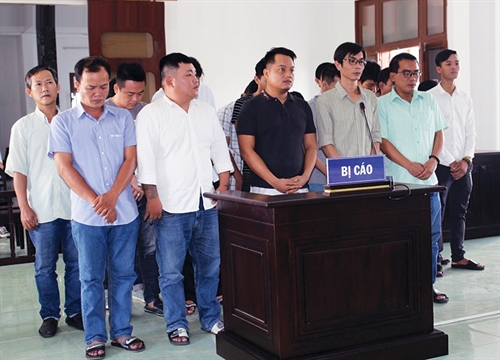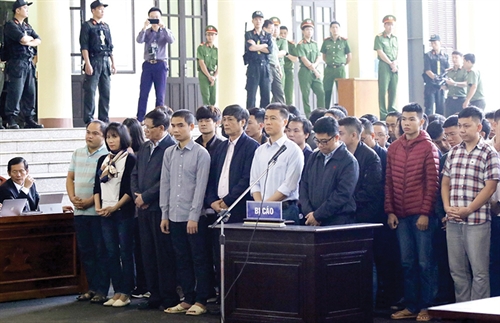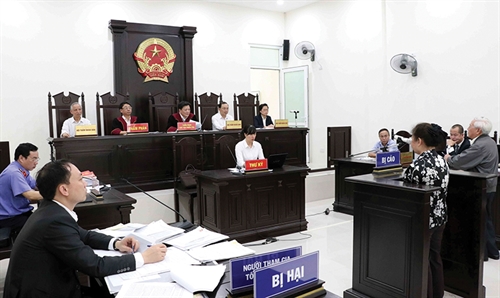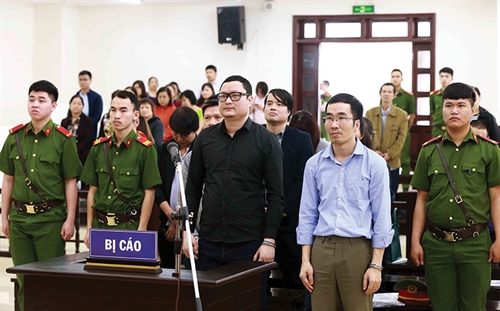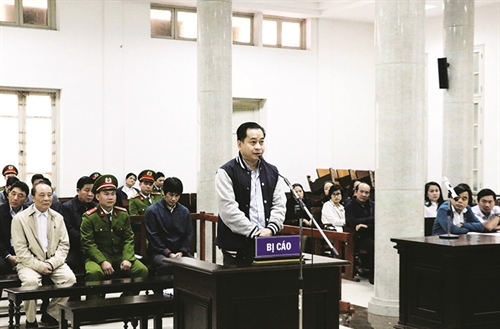Compared to the 1999 version, the 2015 Penal Code’s provisions on protection of wildlife have been significantly revised toward expanding the scope of application of the monetary penalty, increasing penalties and adding some aggravating circumstances. This article analyzes these regulations and proposes a number of recommendations for more effective protection of endangered, precious, and rare wildlife.
Do Duc Hong Ha, Ph.D
Standing Member of the National Assembly’s Committee on Judicial Affairs
Comparison between the 1999 Penal Code and the 2015 Penal Code
Looking at the 2015 Penal Code (the 2015 Code) and its previous version, the 1999 Penal Code and 2007 amendments (the 1999 Code), it can be said that the 2015 Code has more detailed, clear provisions concerning the offenses violating regulations on endangered, precious, and rare wildlife protection.
Firstly, while the 1999 Code has only one article on wildlife-related crime (Article 190 - Violating regulations on protection of animals on the list of endangered, precious, and rare species prioritized for protection), the 2015 Code provides for two offenses related to wildlife protection: (i) violating regulations on management and protection of wildlife (Article 234), and (ii) violating regulations on protection of endangered, precious, and rare animals (Article 244).
The revision aims to incorporate into Vietnam’s law regulations of the Convention on International Trade in Endangered Species of Wild Fauna and Flora (CITES) to which Vietnam is a contracting party and, at the same time, to criminalize acts significantly dangerous to society under CITES, thus filling the “gap” of the 1999 Code and contributing to more effective wildlife protection.
Secondly, the 2015 Code expands the scope of application of the monetary penalty while increasing fine amounts imposed on persons committing wildlife-related crimes.
Under Article 190.1 of the 1999 Code, fines imposed as the principal penalty on violators of regulations on protection of endangered, precious, and rare species range between VND 50 million and VND 500 million. As for those who are subject to other principal penalties and concurrently face a fine as an additionally penalty, the fine level will be between VND 10 million and VND 100 million (Article 190.3).
The 2015 Code now markedly increases fines for violators of wildlife protection regulations. Specifically, fines carried by violators as the principal penalty will range between VND 500 million and VND 2 billion, 10 times and four times higher than the levels prescribed in the 1999 Code (Article 244.1). Meanwhile, fines as an additional penalty will be between VND 50 million and VND 200 million, five times higher than and doubled the levels imposed under the 1999 Code (Article 244.4).
As explained by drafters of the 2015 Code, the expansion of the scope of application of fines as a penalty on wildlife-related offenses and the increase of fine levels conform with the highest levels of fines for similar administrative violations prescribed in legal documents on handling of administrative violations and correspond to the nature and the degree of danger such violations pose to society. More importantly, such a move helps institutionalize the Poliburo resolutions on judicial reform strategy toward 2020 under which the Party sets the objective of “attaching importance to improvement of the criminal policies and judicial procedures, enhancing the deterrence effect and inclination to goodness in handling offenders and expanding the application of fines as criminal penalties. Given the urgent need to protect endangered, precious, and rare wildlife, the severity of wildlife-related crimes as well as the motivation and purpose of these crimes which are to earn profits, the expansion of the scope of application and the increase of fines will better deter and punish offenders.
Thirdly, the 2015 Code also increases the imprisonment penalty for offenses against the regulations on wildlife protection. For example, under the 1999 Code, the imprisonment penalty for such offences is “from six months to three years” and “from two years to seven years” (Clauses 1 and 2, Article 190). Under the 2015 Code, the imprisonment penalties for these offences increase to “between one year and five years” and “between five years and 10 years” Clauses 1 and 2, Article 244).
The increase of imprisonment penalties aims to not only force offenders to take responsibility for their actions but also educate them to obey the law and prevent them from committing new crimes. This also helps improve the public sense and awareness of law observance, especially in the field of wildlife protection, and better prevent and fight wildlife-related crimes.
Fourthly, the 2015 Code quantifies and concretizes aggravating circumstances that affect the determination of penalty ranges. While the 1999 Code provides for aggravating circumstances in a qualitative manner like “causing very serious consequences or particularly serious consequences” (Article 190.2.dd), the 2015 Code prescribes aggravating circumstances in a much more clearer way, making it easier to apply them in reality. Specifically, aggravating circumstances prescribed in the 2015 Code include: (i) involving a quantity of animals or parts inseparable from living bodies of between three and seven individuals of the class Mammalia, seven and 10 individuals of the class Aves or Reptilia, or 10 and 15 individuals of other classes; (ii) involving a quantity of animals or parts inseparable from living bodies of between eight and 11 individuals of the class Mammalia, 11 and 15 individuals of the class Aves or Reptilia, or 16 and 20 individuals of other classes; (iii) involving one or two individual elephants or rhinos or parts inseparable from living bodies of one or two individual elephants or rhinos; or between three and five individual bears or tigers or parts inseparable from living bodies of between three and five individual bears or tigers; and (iv) involving between 20 kilograms and under 90 kilograms of ivories; or between one kilogram and under nine kilograms of rhino horns (Points a, b, c and d, Clause 2, Article 244).
Fifthly, the 2015 Code also specifies, systematizes and expands subjects while supplementing and clarifying the acts and consequences of wildlife-related offenses. For instance, the 1999 Code stipulates the subjects, acts and consequences of the offense of violating regulations on protection of animals on the list of endangered, precious, and rare species prioritized for protection as follows: “Those who illegally hunt, catch, kill, transport and/or trade in animals on the list of endangered, precious, and rare species prioritized for protection or illegally transport and/or trade in body parts of or products from these animals, shall be subject to…” (Article 190.1). The 2015 Code devotes one clause with six points (Clause 1, Article 244) to concretizing, systematizing and expanding the subjects, as well as supplementing and clarifying acts and consequences of the offense of violating regulations on wildlife protection in a comprehensive and complete manner.
As the 2015 Code clearly specifies aggravating circumstances that affect the determination of penalty ranges as well as crime constituent circumstances, individuals, businesses, organizations, units, and agencies have a basis to recognize acts considered offenses as well as corresponding penalties. They will therefore avoid committing crimes and have grounds to remind, educate and prevent their family members and other people from committing crimes. This is an effective approach to crime prevention and combat.
Sixthly, the 2015 Code supplements several new aggravating circumstances which are “gaining illegal profits”, “cross-border trading or transportation”, and “dangerous recidivism”, and adds a crime constituent in Article 234.3 and Article 244.3. These regulations are intended to handle crimes more strictly, fully and comprehensively while differentiating these criminal acts based on their degree of danger to society.
 |
| Vi Van Vuong, middle, is caught red-handed while transporting animals of endangered, precious, and rare species from Laos to the country__Photo: VNA |
Some recommendations
In order to ensure effective implementation of provisions of the 2015 Code on the protection of endangered, precious, and rare wildlife, the author proposes a number of recommendations[1].
Firstly, the Government, provincial-level People’s Committees and functional agencies should enhance communication and education so as to raise public sense and awareness about crimes and violations of regulations on the protection of endangered, precious, and rare wildlife. They should also direct police, ranger, customs and market surveillance agencies to increase inspection, control and handling of illegal hunting, catching, killing, rearing, caging, transporting, trading and storing of endangered, precious, and rare wild animals. Ministries, the Supreme People’s Court and the Supreme People’s Procuracy should regularly organize training and further training courses to provide professional and legal knowledge about protection of endangered, precious, and rare wildlife to law enforcement officers. The training should cover provision of guidelines on newly issued regulations and procedures relating to the handling of cases involving endangered, precious, and rare wildlife so as to ensure that local procedure-conducting agencies have access to updated information and knowledge and can apply law in a consistent manner[2].
Secondly, ministries and provincial-level People’s Committees should comply with Articles 18 and 20 of the 2012 Law on Judicial Expertise on making and announcing the lists of experts qualified for performing judicial expertise of endangered, precious, and rare wildlife. Annually, the Ministry of Agriculture and Rural Development, the Ministry of Public Security and provincial-level People’s Committees should estimate funds for expertise and destruction of evidence and for provision of care and protection of endangered, precious, and rare wildlife being exhibits of administrative violations and criminal cases pending the issuance of handling decisions from procedure-conducting agencies. Funds should be annually allocated to specialized management agencies and rescue centers to carry out the rescue, conservation and re-release of endangered, precious, and rare wild animals seized from violators.
Thirdly, the Ministry of Public Security should continue to coordinate with functional sectors and units in reviewing and studying legal documents on wildlife conservation and, on that basis, propose amendments, supplements and recommendations to tackle difficulties and obstacles in combating wildlife-related crimes. It is also required to enhance state management of farms, tourist areas, craft villages, etc., which conduct activities involving endangered, precious, and rare wildlife to prevent the legalization of animals of illegal origin. Meanwhile, the grant of licenses for raising, trading, transporting, exporting, importing, temporarily importing for re-export of, control of advertisements on social networking sites relating to, and handling of acts of illegally consuming, endangered, precious, and rare wild animals should be rectified and any violations of state officers while performing public duties should be strictly handled. In addition, efforts should be concentrated on law dissemination and education work so as to guide people to observe the law on protection of endangered, precious, and rare wildlife, and to promptly detect and denounce law violations in this field[3].
Fourthly, procedure-conducting agencies should improve the quality and effectiveness of the investigation and handling of crimes and violations in wildlife protection. Investigation agencies should focus on fighting and razing organized crime and transnational crime syndicates engaged in illegal trading, transportation, import, export, temporary import for re-export, advertisement and consumption of endangered, precious, and rare wildlife animals, especially rhino horns and ivories from African countries. The investigation of wildlife-related criminal cases should be accelerated. Relevant agencies should closely coordinate with one another so as to promptly exchange information on cases showing signs of wildlife-related crimes. It is also necessary to promote international cooperation in preventing and fighting crimes and violations in wildlife conservation through close coordination with diplomatic agencies, foreign police and non-governmental organizations, participation in international wildlife conservation campaigns, conferences and training courses, sharing of experiences, techniques and tactics for investigating wildlife-related crimes, and conclusion of agreements on mutual legal assistance in wildlife-related criminal cases with foreign countries[4].-
* The original article belongs to the Supreme People’s Procuracy Magazine (Tạp chí Kiểm sát) and the Wildlife Conservation Society (WCS), Program Vietnam

